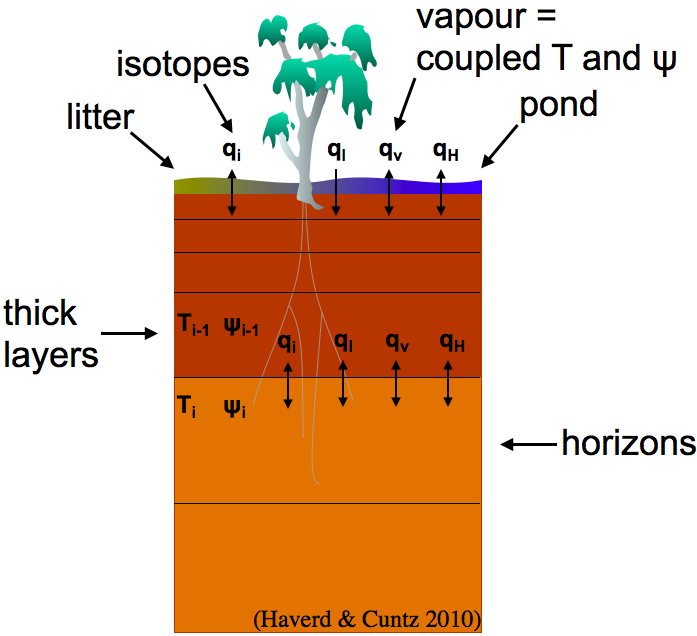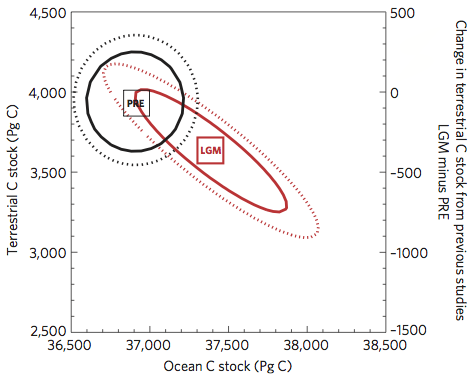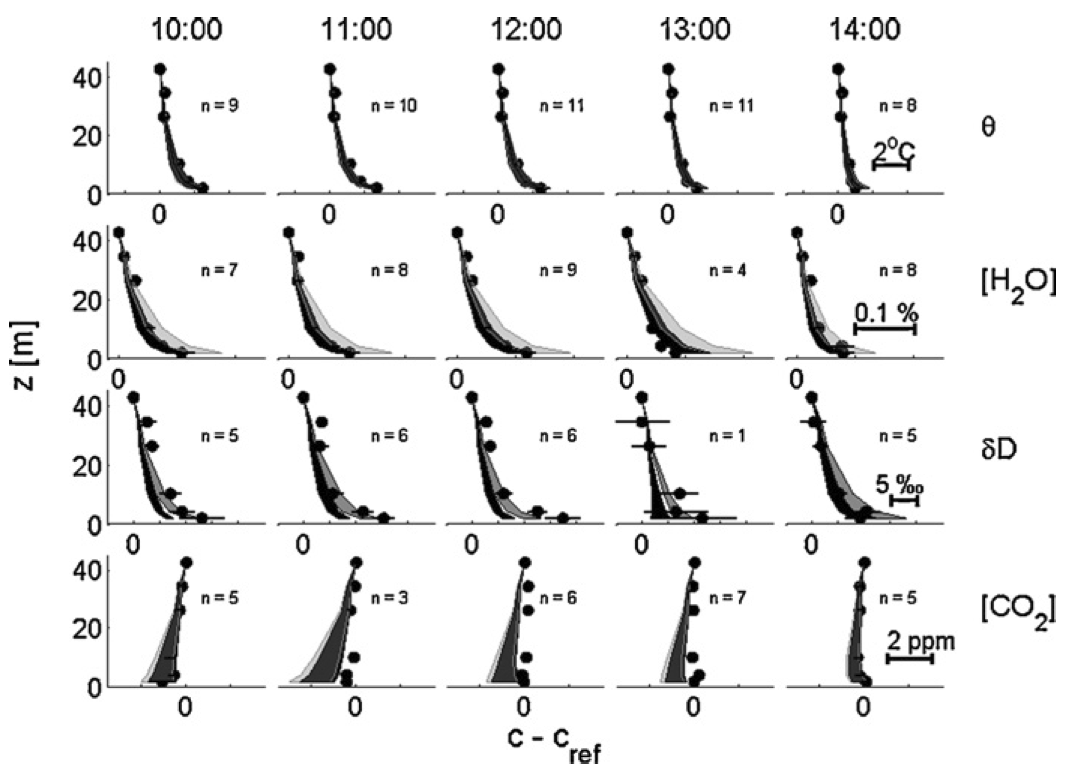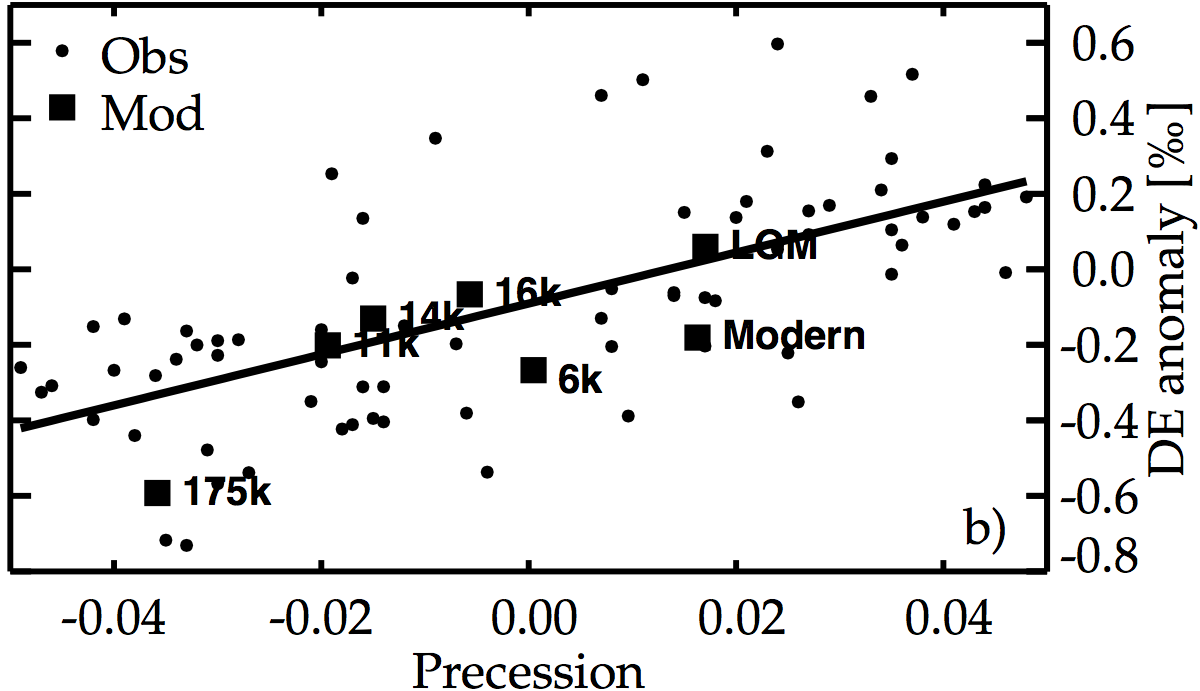Stable Isotopes
Soil-Litter-Iso: A one-dimensional model for coupled transport of heat, water and stable isotopes in soil with a litter layer and root extraction
Large inert carbon pool in the terrestrial biosphere during the Last Glacial Maximum
Measured deuterium in water vapour concentration does not improve the constraint on the partitioning of evapotranspiration in a tall forest canopy, as estimated using a soil vegetation atmosphere transfer model
What drives the Dole effect? A paleo study on the link between marine sediment and Antarctic ice core records
Soil-Litter-Iso: A one-dimensional model for coupled transport of heat, water and stable isotopes in soil with a litter layer and root extraction
 We present a new isotopically enabled hydrologic scheme, "Soil-Litter-Iso", suitable for use as part of an isotopically enabled land surface model. Soil-Litter-Iso is a one-dimensional model for coupled transport of heat, water and stable isotopes (HDO and H218O) in soil and litter. It is sufficiently efficient for use at regional scale, yet includes the complexity of coupled heat and water transport enabling decomposition of the total moisture flux into liquid and vapour components. The numerical implementation is based on Ross' fast solution to the Richards equation (Ross, 2003). This, combined with the explicit solution of the energy and moisture equations at the soil/air interface, permit the isotopic calculations to be performed with thick soil layers and large times steps, resulting in significantly improved computational efficiency compared with existing isotopically-enabled soil models of similar complexity. We demonstrate the model's numerical accuracy by conducting a series of established test-cases and comparing predictions of steady-state isotopic concentration profiles with corresponding analytical solutions. We also demon- strate the model's operation within a land surface model by performing simulations for the forested flux site at Tumbarumba in south-eastern Australia. These simulations show that the total evapotranspiration (ET) flux, its components and their isotopic signatures are very sensitive to the inclusion of litter, and that the model is a useful tool for assessing when the isotopic signatures of the ET components are sufficiently distinct to be useful for flux partitioning.
We present a new isotopically enabled hydrologic scheme, "Soil-Litter-Iso", suitable for use as part of an isotopically enabled land surface model. Soil-Litter-Iso is a one-dimensional model for coupled transport of heat, water and stable isotopes (HDO and H218O) in soil and litter. It is sufficiently efficient for use at regional scale, yet includes the complexity of coupled heat and water transport enabling decomposition of the total moisture flux into liquid and vapour components. The numerical implementation is based on Ross' fast solution to the Richards equation (Ross, 2003). This, combined with the explicit solution of the energy and moisture equations at the soil/air interface, permit the isotopic calculations to be performed with thick soil layers and large times steps, resulting in significantly improved computational efficiency compared with existing isotopically-enabled soil models of similar complexity. We demonstrate the model's numerical accuracy by conducting a series of established test-cases and comparing predictions of steady-state isotopic concentration profiles with corresponding analytical solutions. We also demon- strate the model's operation within a land surface model by performing simulations for the forested flux site at Tumbarumba in south-eastern Australia. These simulations show that the total evapotranspiration (ET) flux, its components and their isotopic signatures are very sensitive to the inclusion of litter, and that the model is a useful tool for assessing when the isotopic signatures of the ET components are sufficiently distinct to be useful for flux partitioning.
Contact:
Matthias Cuntz
Large inert carbon pool in the terrestrial biosphere during the Last Glacial Maximum
 During each of the late Pleistocene glacial-interglacial transitions, atmospheric carbon dioxide concentrations rose by almost 100 ppm. The sources of this carbon are unclear, and efforts to identify them are hampered by uncertainties in the magnitude of carbon reservoirs and fluxes under glacial conditions. Here we use oxygen isotope measurements from air trapped in ice cores and ocean carbon-cycle modelling to estimate terrestrial and oceanic gross primary productivity during the Last Glacial Maximum. We find that the rate of gross terrestrial primary production during the Last Glacial Maximum was about 40 ± 10 Pg C yr-1, half that of the pre-industrial Holocene. Despite the low levels of photosynthesis, we estimate that the late glacial terrestrial biosphere contained only 330 Pg less carbon than pre-industrial levels. We infer that the area covered by carbon-rich but unproductive biomes such as tundra and cold steppes was significantly larger during the Last Glacial Maximum, consistent with palaeoecological data. Our data also indicate the presence of an inert carbon pool of 2300 Pg C, about 700 Pg larger than the inert carbon locked in permafrost today. We suggest that the disappearance of this carbon pool at the end of the Last Glacial Maximum may have contributed to the deglacial rise in atmospheric carbon dioxide concentrations.
During each of the late Pleistocene glacial-interglacial transitions, atmospheric carbon dioxide concentrations rose by almost 100 ppm. The sources of this carbon are unclear, and efforts to identify them are hampered by uncertainties in the magnitude of carbon reservoirs and fluxes under glacial conditions. Here we use oxygen isotope measurements from air trapped in ice cores and ocean carbon-cycle modelling to estimate terrestrial and oceanic gross primary productivity during the Last Glacial Maximum. We find that the rate of gross terrestrial primary production during the Last Glacial Maximum was about 40 ± 10 Pg C yr-1, half that of the pre-industrial Holocene. Despite the low levels of photosynthesis, we estimate that the late glacial terrestrial biosphere contained only 330 Pg less carbon than pre-industrial levels. We infer that the area covered by carbon-rich but unproductive biomes such as tundra and cold steppes was significantly larger during the Last Glacial Maximum, consistent with palaeoecological data. Our data also indicate the presence of an inert carbon pool of 2300 Pg C, about 700 Pg larger than the inert carbon locked in permafrost today. We suggest that the disappearance of this carbon pool at the end of the Last Glacial Maximum may have contributed to the deglacial rise in atmospheric carbon dioxide concentrations.
Contact:
Matthias Cuntz
Measured deuterium in water vapour concentration does not improve the constraint on the partitioning of evapotranspiration in a tall forest canopy, as estimated using a soil vegetation atmosphere transfer model
 Partitioning the evapotanspiration (ET) flux in a forest into its component fluxes is important for understanding the water and carbon budgets of the ecosystem. We use non-linear parameter estimation to determine the vertical profile of the Lagrangian timescale (TL) and partitioning of ET that simultaneously optimise agreement between modelled and measured vertical profiles of temperature, water vapour, carbon dioxide concentrations, and deuterated water vapour for a two-week period in November 2006. High precision real-time trace gas measurements were obtained by FTIR spectroscopy. Modelled temperature and concentration profiles are generated using a Lagrangian dispersion theory combined with source/sink distributions of HDO, H2O, sensible heat, and CO2. These distributions are derived from an isotopically enabled multilayer Soil Vegetation Atmospheric Transfer (SVAT) model subject to multiple constraints. The soil component of the model was tested in isolation using measured deuterium content of soil chamber evaporate, while the leaf component was tested using isotopic analyses of leaf and xylem water, combined with leaf-level gas exchange measurements. Optimisation of TL and the partition of ET was performed twice: once using only temperature, H2O and CO2 profiles and a second time including HDO as well. The modelled vertical concentration profiles resulting from inclusion of HDO in the cost function demonstrate our ability to make consistent estimates of both the scalar source distributions and the deuterium content of the water vapour sources. However, introducing measurements of deuterium in water vapour does not significantly alter resulting estimates of normalised TL (0.4 ± 0.1 at canopy top) and the partition of ET (85 ± 2% transpiration), suggesting that the additional data and modelling required to use deuterium are not warranted for the purpose of partitioning ET using the framework presented here.
Partitioning the evapotanspiration (ET) flux in a forest into its component fluxes is important for understanding the water and carbon budgets of the ecosystem. We use non-linear parameter estimation to determine the vertical profile of the Lagrangian timescale (TL) and partitioning of ET that simultaneously optimise agreement between modelled and measured vertical profiles of temperature, water vapour, carbon dioxide concentrations, and deuterated water vapour for a two-week period in November 2006. High precision real-time trace gas measurements were obtained by FTIR spectroscopy. Modelled temperature and concentration profiles are generated using a Lagrangian dispersion theory combined with source/sink distributions of HDO, H2O, sensible heat, and CO2. These distributions are derived from an isotopically enabled multilayer Soil Vegetation Atmospheric Transfer (SVAT) model subject to multiple constraints. The soil component of the model was tested in isolation using measured deuterium content of soil chamber evaporate, while the leaf component was tested using isotopic analyses of leaf and xylem water, combined with leaf-level gas exchange measurements. Optimisation of TL and the partition of ET was performed twice: once using only temperature, H2O and CO2 profiles and a second time including HDO as well. The modelled vertical concentration profiles resulting from inclusion of HDO in the cost function demonstrate our ability to make consistent estimates of both the scalar source distributions and the deuterium content of the water vapour sources. However, introducing measurements of deuterium in water vapour does not significantly alter resulting estimates of normalised TL (0.4 ± 0.1 at canopy top) and the partition of ET (85 ± 2% transpiration), suggesting that the additional data and modelling required to use deuterium are not warranted for the purpose of partitioning ET using the framework presented here.
Contact:
Matthias Cuntz
What drives the Dole effect? A paleo study on the link between marine sediment and Antarctic ice core records
 The 18O/16O composition of atmospheric oxygen called the Dole Effect (DE) when expressed relative to the 18O standard of mean ocean water in δ-notation as δ18OAtm) is one of the key paleo proxies measured in polar ice cores. The DE was measured in the Vostok ice core spanning the last 4 glacial/interglacial cycles and will soon be measured in the new EPICA Dome C ice core for the last 8 cycles. The DE record shows a marked 23000 year precessional periodicity over the last 400 kyr, provides dating information for ice cores. Here we focus on two key periods of the Past: the last glacial maximum (LGM) when the DE was similar than today, and the 175 kyrs BP period when the DE was significantly higher than today by 0.5 permil. In order to interpret these DE variations, we built spatially explicit global models of marine and terrestrial oxygen fluxes, combined with simulations of the global water isotope distribution. The ocean oxygen model has relatively high dissolved O2 turnover rates in the photic layer, implying that the 18O fractionation during marine respiratory uptake of dissolved O2 is higher in former studies. The terrestrial oxygen flux model accounts for biome dependent soil diffusion fluxes. We explain the LGM relative stability and the strong precessional periodicity of the DE by spatial redistributions in the terrestrial productivity, associated with changes in the atmospheric water cycle. The main result is that ocean productivity changes play only a minor role in past variations of the DE. Although our combined land and ocean DE model can explain for the fist time the observed past variations in DE, uncertainties remain large, in particular for soil O2 diffusion. Terrestrial processes are non-linear and therefore, any ice core dating method based on empirical linear relationships between insolation and DE signal should viewed with caution.
The 18O/16O composition of atmospheric oxygen called the Dole Effect (DE) when expressed relative to the 18O standard of mean ocean water in δ-notation as δ18OAtm) is one of the key paleo proxies measured in polar ice cores. The DE was measured in the Vostok ice core spanning the last 4 glacial/interglacial cycles and will soon be measured in the new EPICA Dome C ice core for the last 8 cycles. The DE record shows a marked 23000 year precessional periodicity over the last 400 kyr, provides dating information for ice cores. Here we focus on two key periods of the Past: the last glacial maximum (LGM) when the DE was similar than today, and the 175 kyrs BP period when the DE was significantly higher than today by 0.5 permil. In order to interpret these DE variations, we built spatially explicit global models of marine and terrestrial oxygen fluxes, combined with simulations of the global water isotope distribution. The ocean oxygen model has relatively high dissolved O2 turnover rates in the photic layer, implying that the 18O fractionation during marine respiratory uptake of dissolved O2 is higher in former studies. The terrestrial oxygen flux model accounts for biome dependent soil diffusion fluxes. We explain the LGM relative stability and the strong precessional periodicity of the DE by spatial redistributions in the terrestrial productivity, associated with changes in the atmospheric water cycle. The main result is that ocean productivity changes play only a minor role in past variations of the DE. Although our combined land and ocean DE model can explain for the fist time the observed past variations in DE, uncertainties remain large, in particular for soil O2 diffusion. Terrestrial processes are non-linear and therefore, any ice core dating method based on empirical linear relationships between insolation and DE signal should viewed with caution.
Contact:
Matthias Cuntz
